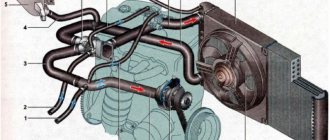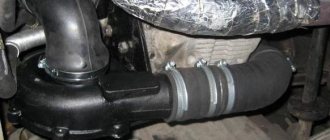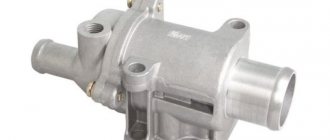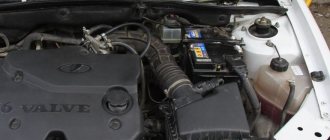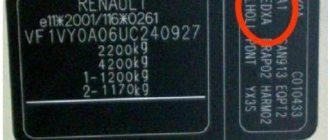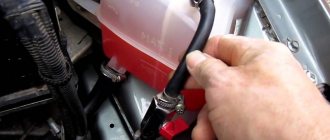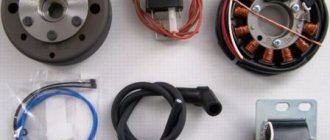Lada Priora cannot be called a miracle of engineering in terms of technical equipment. For the most part, this model inherited the components and assemblies of its predecessors. The cooling system was no exception. On the Lada Priora it is combined: liquid with partial natural and forced air cooling. In this case, the type of engine does not matter: for the 8-valve and 16-valve power units it is almost identical.
Device and features
The cooling system of the Priora internal combustion engine has a standard set of main components:
- radiator;
- thermostat;
- electric fan;
- water pump;
- heater;
- engine jacket;
- connecting hoses;
- expansion tank.
By circulating through the large and small circuits, the coolant prevents the engine from overheating, maintaining the desired temperature. Structurally, the cooling system of the Priora is simple and no different from other internal combustion engines with an injector, with the exception of small parts.
Radiator and forced cooling fan
They mainly serve to bring the working fluid to the optimal temperature for the functioning of the engine (the operating temperature of the Priora engine with 16 valves is 90–95 degrees). The predecessor of the Priora VAZ 2110 often installed a cooler made of copper alloys, but due to cheaper prices, designers switched to aluminum analogues.
The operation of the fan depends on the engine control unit.
It receives information from the DTOZH (this is a sensor that reads temperature readings) located in the water jacket of the power unit. If the permissible temperature values are exceeded, the control unit connects an electric fan to improve cooling efficiency. A faulty fan or clogged radiator can lead to a constant increase in optimal engine temperatures, which shortens the service life and can cause costly repairs.
Thermostat
Its task is to promptly open coolant access to a large circle of the engine cooling system (engine cooling system) after the engine reaches the optimal temperature. In simple terms, the thermostat allows you to quickly warm up the engine and regulates the operation of the entire system. During warming up, the thermostat valve is in the closed position, antifreeze does not flow through the large circuit (the radiator is not activated). As it warms up, the valve opens slightly under the influence of rising temperature, and antifreeze begins to move through the radiator along a larger circuit.
A thermostat malfunction can result in overheating of the power unit (if the valve is stuck closed) or, conversely, the operating temperature rises very slowly (when the valve is stuck in the open position). Overheating is much more dangerous. Beginners can identify this malfunction if the engine heats up all the time and the fan on the Priora is constantly running.
Pump (water pump) and heater
Without the first part, the coolant circulation circuit in the system is impossible. If the water pump is faulty, at best there will be a coolant leak from the system. In the worst case, the pump may jam, which will lead to a broken timing belt and subsequent problems, the solution of which will result in expensive repairs.
The heater, or simply the stove, consists of a radiator, pipes and a fan. Can additionally cool the antifreeze in the system. An indispensable unit in winter. Provides the interior with warm air.
Connecting elements and expansion tank
It serves as a receiving compartment where gases and vapors are discharged when the coolant is heated. Also, the expansion tank is the level for the entire cooling system. One of the main elements in the tank is the valve cover through which air is forced out. There is antifreeze, it begins to boil when the engine temperature rises critically.
The connecting hoses serve as a pipeline for the circulation of coolant and connecting elements of all structural units, thus creating a single looped and sealed circuit.
The design of the cooling system also includes an engine temperature sensor on the Priora and an engine jacket. The sensor constantly reads information about the current antifreeze temperature and transmits it to the ECU. The location of the power plant jacket is structurally assumed in the cylinder block housing; it serves to remove heat through the coolant.
Description
A complete set of pipes for the 21126 Priora engine solves the problem of selecting and finding the necessary pipes for replacement.
Material: reinforced rubber (2-layer).
Size: wall thickness 4 mm.
Advantages: reliability and aesthetic appearance.
1.2170-1303025-10A-sport = Radiator inlet pipe = 1 piece;
2.2112-1014056A-sport = Breather pipe = 1 piece;
3.2170-1303010-10A-sport = Radiator outlet pipe = 1 piece;
4.2112-1148035A-sport = Air filter pipe = 1 piece;
5.2112-1014058A-sport = Breather pipe (analogue 21124) = 1 piece;
6.2170-1303080A-sport = Expansion tank pipe = 1 piece;
7.2170-8101200A-sport = Heater supply pipe = 1 piece;
8.2170-8101208A-sport = Heater outlet pipe = 1 piece;
9.2112-1008658A-sport = Red plate bushing = 4 pcs
You can pay for your purchase in any convenient way:
- VISA, MasterCard (no commission)
- Receipt for payment
- Sberbank Online
We deliver goods throughout Russia and Kazakhstan
We can send your purchase to you by transport company:
Lower breather hose for VAZ 2110-2112, Lada Priora, Kalina, Granta
Blue silicone radiator pipes for Lada Priora
Red reinforced rubber radiator pipes for Lada Priora
Blue silicone hose 1 meter diameter 20 mm
Heater pipes reinforced rubber red for Lada Priora
Blue silicone heater pipes for Lada Priora
Blue silicone hose 1 meter diameter 8 mm
Thermostat pipe injector corner for VAZ 2108-21099, 2110-2112, 2113-2115, Priora
Filling pipe for the cooling system of the expansion tank on Lada Priora
Air intake of OAT air filter for Lada Priora
Small outlet pipe for the heater in the passenger compartment on Lada Priora
Lower radiator outlet hose (pipe) for 16 cells VAZ 2110-2112, Lada Priora
Heater supply pipe (to the engine compartment, long) on Lada Priora
Cold air intake pipe for Lada Priora with air conditioning
Water pump supply pipe for VAZ 2110-2115, Lada Priora, Vesta, X-Ray
Upper radiator hose (pipe) supplying 16 cells VAZ 2110-2112, Lada Priora
Lower radiator outlet pipe for Lada Priora with air conditioning
Upper radiator supply pipe for Lada Priora with air conditioning
Upper crankcase exhaust ventilation hose (pipe) Forward Automatic spare part for VAZ 2110-2112, Lada Priora sedan
Set of engine pipes silicone blue cs20 profi for Lada Priora
Expansion tank hose to thermostat Forward Auto spare part for Lada Priora sedan
Radiator pipes for Lada Priora
Pneumatic drive system hose (long) for Lada Priora, Kalina 2, Granta, Vesta
Lower crankcase ventilation hose a-sport for Lada Priora, Kalina 2, Granta, Vesta
Set of heater pipes for Lada Priora
Water pump supply pipe for Lada Kalina, Priora sedan, Granta sedan, Vesta, X-Ray, Datsun
Breather pipe (hose) Forward Auto spare part for VAZ 2110, Lada Priora sedan
Lower radiator outlet hose (pipe) Forward Auto spare part for Lada Priora
Radiator upper supply pipe Forward Auto spare part for Lada Priora
The internal structure of a car is a very complex combination of functions and devices, the functionality of which is ensured by various systems. One of these is the cooling system (SOD), which regulates the temperature both under the hood and inside the car during hot periods.
And, of course, over time or when overloaded, some parts of this system fail, leading to serious consequences, and this is partly true for everyone’s favorite Lada Priora. Therefore, if you notice poor performance of the stove or overheating of the engine, the first thing you need to do is check the ODS.
Often the problem lies in the hoses or pipes of the system, which could “come off” or become leaky. This is not the worst problem, which can be solved by simply purchasing new (ideally silicone) parts and installing them. It is these hoses and pipes, as well as those made of reinforced rubber, that you will find on this page of our store and can be purchased with the necessary help from our consultants.
Features of cooling system malfunctions
The efficiency of the structure primarily depends on the level of antifreeze in the system and its condition (this liquid has a certain resource, usually up to three years or up to 50,000 km). The main sources of system malfunctions are the thermostat, radiator and electric fan, as well as the water pump, the principle of operation of which is described above.
The radiator most often becomes the source of antifreeze leakage. Accordingly, the liquid level in the system drops, and there is not enough of it for effective heat removal. The motor begins to overheat. It can also be clogged with garbage. And if water is used instead of antifreeze the old fashioned way, scale may form.
The consequences of a faulty water pump are much more serious. In addition to antifreeze leakage, the circulation of coolant in the system may stop and, as a result, the engine will quickly overheat. The worst case scenario is bent valves due to a broken timing belt.
The next common malfunction is burnout of the cylinder head gasket or deformation of the cylinder head of the internal combustion engine system. This leads to coolant entering the fuel combustion chambers. The same thing can happen if cracks appear on the cylinder block.
Coolant leakage is most often associated with loss of tightness of the connecting pipes, because over time, the material from which they are made hardens and wears out, as a result of which it cannot work properly.
On a Priora, a lot depends on the computer, and a faulty coolant temperature sensor can give incorrect readings. For example, if the ECU receives underestimated performance, the engine will begin to overheat. Otherwise, the fan will be constantly on. On the other hand, often the cooling system sensor does not transmit any readings at all. Then the ECU switches the operation to emergency mode.
Causes of malfunctions
Why do problems occur in cooling systems? The following factors usually play a role:
- natural wear and tear of components;
- mechanical damage;
- operation of the engine in violation of maintenance rules;
- failures in the electronics (for example, an error in the Priora coolant temperature sensor).
In addition, breakdowns can be caused by low-quality spare parts and coolant, mixing antifreeze of different brands, and unqualified repair work. If problems occur with the cooling system, they should be addressed immediately. In some cases, ignoring problems will cause complete failure of the power unit.
This can happen due to coolant getting into the oil sump or engine overheating due to low fluid level (a faulty thermostat can also be one of the reasons). In turn, operating an overheated motor leads to its jamming. Considering these facts, we can conclude that the cooling system must be constantly monitored. The antifreeze level should always be normal; the coolant that has exhausted its life should be changed in a timely manner.
You can notice problems yourself; for this there is no point in contacting a car service.
And repair work on replacing and servicing the cooling system of the Lada Priora can be done with your own hands. There is nothing complicated about this. With the exception, perhaps, of the pump, where you will have to deal with installing a timing belt. In this case, it is better for beginners to entrust the procedure to professionals. Depending on the region, the cost of such services does not exceed 1,500 rubles, and this is the most expensive system repair operation; the rest are priced less.
Signs of trouble
Problems can be identified by obvious symptoms.
| What's happening | What the instruments show and how the nodes behave | Probable Causes |
| Engine overheating. | A light on the instrument panel lights up indicating this. This can also be recognized by the arrow of the coolant temperature indicator on the same instrument panel. If the indicator is faulty, overheating will be indicated by a cooling fan running almost continuously. Systematic overheating of the engine can be determined by the spark plugs - a white coating appears on them; in good condition the engine has a sand-colored coating. | If the engine overheats, there may be a coolant leak from the system. |
| Another sign of a malfunctioning cooling system is a cold engine, which for a long time (especially in winter) cannot warm up to the optimal temperature. | This can be seen from the readings on the dashboard. You can also understand this by turning on the heater. In such situations the air will be cool. | Thermostat stuck open. Operating a cold engine under normal loads is not allowed. |
To determine the cause, you should visually check all pipes and elements of the system for leaks.
If no leaks were detected externally, and the level of antifreeze in the tank is still decreasing, then perhaps the problem is internal leaks.
This is much more dangerous, because antifreeze gets into the oil. You can determine it by the color of the exhaust gases: in such cases, the smoke will be white. In addition, the engine oil level becomes higher.
Methods for diagnosing faults
Identifying problems in the Priora cooling system begins with checking the coolant level in the expansion tank. Optimally – between the minimum and maximum. An antifreeze level below the minimum mark is unacceptable, as this will cause overheating. If the antifreeze is cloudy, with impurities, it means its service life has expired and should be replaced. It is advisable to flush the cooling system before doing this. If, after topping up, the antifreeze still disappears somewhere, then you need to check the tightness and presence of leaks on the expansion tank, pump, connecting pipes, etc. There may also be a leak on the radiator, including the heater.
If the level is normal, but the Priora engine gets hot, then the reason is a faulty thermostat. It's easy to check its operation. Start the cold engine and let it idle for a while. If the thermostat is working properly, the lower part of the radiator will gradually heat up. If the lower radiator pipe begins to heat up immediately, it means that the thermostat is stuck in the open position and antifreeze immediately circulates in a large circle on a cold engine. The thermostat cannot be repaired and must be replaced if a problem occurs.
A much more serious problem is a faulty pump. You can determine the breakdown in this way.
- The engine temperature rises quickly immediately after starting.
- Noise in the area of the water pump during operation of the power plant.
- Antifreeze leaks under the pump.
The noise of the pump indicates a worn bearing, and rapid heating is associated with a lack of coolant circulation. Antifreeze leaks indicate a failed oil seal.
The water pump cannot be repaired and must be replaced.
Engine operating temperature
We have learned the resource, now we move on to another important indicator. The optimal operating temperature is 90-95°C
After 97°C, engine number 126 with 16 valves will “slow down” a little, but according to the rules, temperatures up to 100°C are considered normal. If the Lada unit is operated with this indicator, then you need to be sure that the radiator fan is running at this time. When you see an indicator below +90°C on the dashboard, you need to assume that this is underheating. Of course, in cold weather the power plant needs more time for the temperature to reach normal levels.
Remember:
- Operating temperature – 90-95°C.
- Normal temperature (engine runs worse) is 97-110°C.
- Reduced temperature – 90°C and below.
Replacing elements
Structurally, the Lada Priora engine cooling system has a simple design. Therefore, we will consider replacing only individual components, with which certain difficulties are possible, especially for beginners.
Replacing the cooling system radiator
This unit on cars rarely changes. Typically, this procedure is necessary when a leak occurs that cannot be eliminated. Its service life can be 10 years or more. Cases when replacing the radiator are simply necessary are as follows:
- unprofessional repairs in the engine compartment, during which the radiator cooler tubes were damaged;
- damage as a result of an accident;
- Increased pressure in the system caused the leak.
Removing the old and installing a new radiator, as well as replacing antifreeze on a Priora with air conditioning, is somewhat more difficult. Therefore, to save time and nerves, it is better to entrust this matter to professionals. If there is no air conditioning, you can change the radiator yourself.
Algorithm of actions.
- Unscrew the drain plug at the bottom of the radiator and drain the antifreeze into a suitable container.
- Show all the pipes that go to the radiator.
- Unscrew the fastening nut from the top and right side.
- The fan can be left on the radiator; it can be removed at any time.
- Move the radiator towards the engine and lift it up, thereby removing it from the engine compartment.
If the fan remains on the radiator, you need to disconnect the terminal from it. Installation of a new radiator is carried out in the reverse order of removal. If necessary, you can change the antifreeze.
Replacing the thermostat
Another important element of the cooling system, which can be changed independently. This is done as follows.
- The car needs to be placed on a viewing hole, or at least hang the front part so that it is possible to crawl up from below.
- Unscrew the cap of the expansion tank.
- Remove the engine protection (if there is one) and unscrew the drain plug on the cylinder block from below (not visible from above).
- Before unscrewing the drain nut, you need to place a suitable container under it. Then you can unscrew the plug and drain the coolant. Work is carried out on a cooled engine, otherwise there is a high risk of getting burns.
- Under the air filter to the right of the cylinder block you need to find the thermostat and, by loosening the clamp nuts, remove the pipes from it.
- Using a hexagon, unscrew the thermostat fasteners and remove it.
Before installing a new thermostat, you should pay attention to the rubber seal where it is attached to the block. To improve the tightness, it is necessary to coat it with a silicone gasket sealant. Next, all that remains is to install a new thermostat, connect all the pipes and fill in the coolant. After this, you need to start the engine and warm it up to 90 degrees, then inspect the thermostat and pipes for leaks. If necessary, you need to add antifreeze and remove the air lock, if any.
After replacing the thermostat, all that remains is to check its functionality. If the thermostat is working properly, the lower radiator hose should be cool when starting and running a cold engine. You need to let the engine run until it reaches operating temperature.
After the pointer on the instrument panel shows 90 degrees, you need to touch the lower pipe again. It should heat up smoothly. If this does not happen, the thermostat is faulty.
Preparatory stage
Before you start, you should do the following:
- choose and buy a suitable cooler;
- stock up on a new cover mount in case the old one is damaged;
- take the wrench;
- find a container where you will send the waste liquid;
- buy rags.
Algorithm of actions
To replace antifreeze in Priora, follow the instructions:
- Send the car to a garage with plenty of free space to work on. Cool down the engine. All actions must be performed on a cold engine system.
- Get rid of high blood pressure. Open the cap of the reservoir containing the antifreeze. If the engine is hot, fluid may splash out. Use a cloth and gloves for protection.
- Remove the protection that is installed on the propulsion system. Unscrew the bolts on the mount. The latches do not need to be removed. They will not interfere with the process.
- If a transmission with cables is installed, it must be removed. To do this, disconnect power from the battery. Remove the protective coating with a wrench.
- Now you need to drain the entire volume of liquid. To do this, unscrew the fixing cap. Place a container below where the waste material will be drained. Wait until all the refrigerant has left the tank. Assess the condition of the latch. If signs of wear are noticeable, replacement is recommended.
- If there are any cloudy traces in the coolant, it is recommended to flush all the channels in the car. To do this, add purified water. Add citric acid or vinegar to remove any remaining dirt. Flush the system until the water runs clear. Only after this can you fill the coolant into the tank.
- Assess the condition of the hoses. If they are worn out, replace them.
- Using a hose, pour new fluid into the container. Avoid high internal pressure.
- Refrigerant is added until the tank is filled to the optimum level.
- All disassembled parts are reassembled in reverse order.
- Start the engine and take it for a test drive. After this, check if all systems are normal.
Flushing the cooling system of Lada Priora
It becomes dirty and clogged over time and intensity of use. Clogged SOD channels do not allow antifreeze to circulate freely, as a result, heat transfer is disrupted. The stove in the cabin begins to heat poorly, and meanwhile the engine constantly overheats. In these situations, the right solution would be to clean the cooling system. To do this, first of all you need to cool the engine.
The following is the procedure.
- Drain the coolant (not only from the radiator, but also from the engine jacket, by unscrewing the drain plug on the cylinder block).
- Fill the expansion tank with any suitable flushing fluid to the optimum level.
- Start the engine and let it idle for at least 15 minutes.
- Drain the used fluid.
Then, if necessary, the procedure is repeated. After flushing, all that remains is to fill in fresh antifreeze and remove the air lock from the system. If a more thorough flushing of the system is required, then there is nothing complicated here either. To do this, you will need a regular watering hose connected to the water supply. To flush the radiator, you need to disconnect the lower and upper pipes, insert them into the upper hose and turn on the water. All dirt and rust will come out of the bottom. To flush the engine jacket, you need to do the same steps, but the hose is inserted into the thermostat pipe.
The effectiveness of flushing the system largely depends on the product chosen as a flushing agent.
The simplest option is regular tap water. Add lemon juice to it. Carbonated drinks, such as cola, are also suitable. You can also buy special cleaning products for washing SOD in specialized stores.
Airlock
An air lock in the SOD is the formation of air in the system, which does not allow it to function properly. A plug is a cavity of air that forms in the heater radiator and most often negatively affects the operation of the interior heater.
How to remove a traffic jam?
The SOD device in Priora does not imply air pockets; during operation, they are independently removed by the system without any intervention. All you have to do is run the car for a few tens of minutes and the traffic jam will go away.
There is also a way to remove the plug much faster. You need to drive your car up a hill so that the front of the car is slightly higher than the rear, open the expansion tank cap and keep the engine speed around 2000-2500 rpm. The air lock will come out.
How to expel air, method No. 1
- Remove the hose from the throttle body heating.
- Open the cap of the expansion tank, cover the neck with a clean rag and blow into the tank.
- When antifreeze starts flowing from the removed tube, quickly put the hose back in place and tighten it with a clamp.
Attention! Coolant is a toxic substance, so we recommend that you use other methods to solve the problem.
SOD components
The cooling system includes many different parts that are responsible for the correct operation of the system. To understand the purpose of these parts, you need to take a closer look at them.
Cooling radiator
This part is designed to cool antifreeze while the car is moving. As coolant circulates through the radiator it cools and therefore cools the engine block. Inside, the radiator consists of many tubes connected to each other by a snake.
Possible breakdowns:
- Antifreeze leaking from radiator joints;
- Radiator clogged with oxidation products;
Water pump (Pump)
The pump is a pump that circulates liquid through the cooling system. Circulation is ensured by the pump impeller based on the principle of centrifugal force. The pump rotates using the crankshaft through the timing belt.
Possible breakdowns:
- Coolant leaks through the oil seal;
- Wear of ball bearings;
- Impeller failure;
Thermostat
The thermostat is one of the main elements of the Priora engine cooling system. Inside the thermostat housing there is a valve with a thermoelement, which is responsible for opening and closing a large circle. When the coolant is heated to a temperature of 85⁰C, the thermostat valve opens and the liquid begins to pass through the cooling radiator, thereby cooling down and preventing the engine from overheating.
Possible breakdowns:
- Valve jamming in one of the positions;
Expansion tank
The expansion tank is designed to compensate for the expansion of the liquid during heating, as well as the contraction during cooling. It is for these reasons that the amount of liquid in the tank is at an average level.
Possible breakdowns:
- Tank rupture due to a breakdown of the cylinder head gasket;
- Cracks in the tank due to old age;
Expansion tank cap
The main task of the tank cap is not only to close the opening of the coolant tank, but also to relieve excess pressure in the system. It is in the lid that a valve is installed that operates in two positions: pressure release and vacuum release (vacuum). If there were no valve, the pressure in the system would inflate the hoses and rupture the expansion tanks.
Possible breakdowns:
- Valve jamming;
- Loss of tightness;
Cooling Fan
Designed to cool the engine in a traffic jam or when the car is stationary. As you know, the radiator effectively cools the car when there is a headwind, that is, when driving. When stuck in a traffic jam, the cooling of the car is reduced to zero, so a fan is used as an artificial wind, which turns on at a certain temperature and cools the liquid.
Possible breakdowns:
- Fan motor malfunction;
Heater radiator
The heater radiator and the cooling radiator have a similar design, but differ in size and purpose. The purpose of the heater radiator is to heat the vehicle interior. It is installed in the stove body in the engine compartment and has two input and output fittings.
Possible breakdowns:
Pipes
The pipes are responsible for the circulation of fluid from one part to another throughout the system. They are made of rubber that is resistant to temperature loads; inside each pipe there is a reinforced thread that does not allow the pipe to swell due to pressure in the system.
Possible breakdowns:
- Cracks;
- Drying of rubber over time;
Source
What kind of oil to fill in Priora: engine oil for a 16-valve engine
Lada Priora with a 16-valve engine is a popular and fairly common model, since the line of these power units means modern, fairly powerful and economical engines.
In fact, the most popular engines were the VAZ-21126 (displacement 1.6 liters, 16 valves, power 98 hp), as well as the VAZ-21127 (1.6 liters, 16 liters, 106 hp). There is also the not so common VAZ-21128 (1.8 liter, 16 liter, 120 hp).
Next, we will look at what kind of oil is best to pour into a Priora engine, what kind of oil to pour into a Priora 16 valve, and also what needs to be taken into account when selecting engine oil and subsequent operation of the car.
Benefits of modernization
Replacing a standard thermostat with a device from Lada Granta does not take much time and can be done on your own without contacting a service center. Modernization has a number of advantages:
- The power unit warms up faster.
- The car interior begins to warm up when the temperature reaches 50 degrees.
- After 70 degrees, hot air flow begins.
- The engine does not overheat at idle.
- The problem of depressurization of the cooling system completely disappears.
Now the heating radiator does not depend on the pressure of the water pump and the opening of the bypass valve. The circulation of antifreeze in a small circle occurs consistently, without the influence of temperature and pressure.
